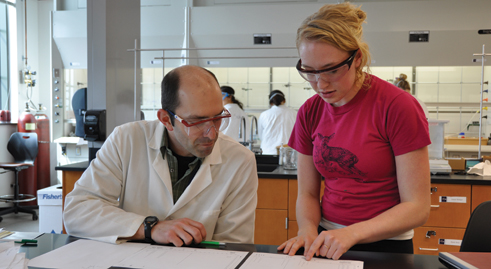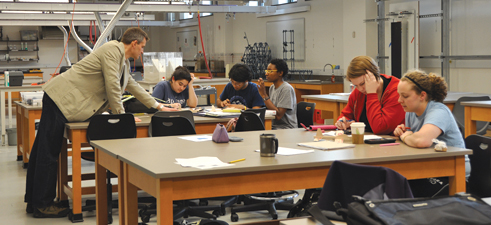Ford Hall Provides New Space for Scientific Collaboration, Exploration
By Eric Goldscheider
"A love affair," is how Ileana Streinu, Charles N. Clark Professor of Computer Science, describes her relationship with Ford Hall. It is not just the state-of-the-art facilities that she loves, says the Romanian-born scholar recognized for her groundbreaking research in computational geometry, it is also the feel and the atmosphere. "There is so much light here," and the way the space is organized is "conducive to communication and collaboration."
Other professors are just as effusive, using words like "amazing," "spectacular" and "remarkable" to express their ardor. Associate Professor Kevin Shea, who joined the chemistry department 10 years ago upon completing a doctorate at the Massachusetts Institute of Technology, says the opportunity to be in on planning a new facility for scientific exploration and pedagogy was a "once in a career" treat. "We are all thrilled about teaching in all these amazing teaching labs and really getting our students engaged."
They are referring, of course, to Smith's new state-of-the-art science and engineering building where classes were taught for the first time this spring semester. The $73 million, 142,000-square-foot structure offers classrooms, teaching and research labs, meeting rooms and faculty offices for the departments of computer science, chemistry, biochemistry, molecular biology and the Picker Engineering Program. It is named for the lead donor to the project, the Ford Motor Company Fund.
In the previous science facilities at Smith, laboratories were separate from classrooms, and professors had their offices scattered throughout the Clark Science Center.
The chemistry teaching labs in Ford Hall have an open communal space where students and teachers can congregate around a long table for pre-, mid- and postlaboratory discussions or for instructional interludes with a full blackboard and projection capabilities. "It's a really functional space; this has been a huge advance for us," says Shea.

Kevin Shea, associate professor of chemistry, and Julie Olson '10 discuss data related to a molecule that Olson synthesized in the lab for her thesis research. Photo by Judith Roberge.
Lecture halls and classroom spaces are well equipped and allow a chemistry professor to do scientific demonstrations in real time. "You lose something if you can't do some really fun and interesting experiments that you just can't do without a [ventilation] hood," says Shea. He has been known to make gummy bears explode (with sparks and all) in an oxidation reaction and to create almost instant plumes of purple vapor by combing turpentine and iodine. "You can write those reactions on the blackboard and ask what's going on, but it's much more interesting to see the chemical phenomenon in front of you," says Shea. "It helps you remember it and get engaged with it; that's why people become interested in chemistry."
Established in 1962 to recognize women who exemplify in their lives and work "the true purpose" of a liberal arts education, the honor will be bestowed at Rally Day on February 17.
Susannah Howe, lecturer in engineering, directs Design Clinic, the capstone component of the Picker Engineering Program. Ford Hall has enabled her to create an office environment in which each year's seniors break up into teams to tackle design problems for actual clients. It is an eight-credit required course; this year Smith women worked on projects like designing a geothermal heating and cooling system for a Stop & Shop supermarket, devising ways to reduce nitrogen in the Northampton wastewater treatment plant and creating a solar-powered microirrigation system for the Natural Resources Conservation Service. "The students were working with actual clients so we really needed spaces where they could do their work, store their files and have their meetings," says Howe.
One of Howe's groups took full advantage of the new facilities in building actual prototypes of a high-resolution microbial mat sampler that was slated for use this summer by the Woods Hole Oceanographic Institute on deep submergence vehicles. In addition to using one of the well-appointed cubicles that Design Clinic students make their own for their senior year, this group was able to go into the fabrication facility in the basement to work with equipment like a lathe, a laser cutter, and a water jet cutter for machining components.
Etta Grover-Silva '10, part of the microirrigation team, says, "Having this space to be able to meet at any hour of the day to work on our project has been monumental." Team member Katy Gerecht '10 agrees. "We all know very intensely how amazing this facility is."
Steven Williams, Gates Professor of Biological Sciences, who has spent his 27 years at Smith studying infectious diseases, was the first to move his lab into Ford Hall. "One of the great things about Ford Hall is that everything we need to do the kind of high-tech research we aspire to is all here."
His students are deeply involved in his work as part of an international effort to eliminate tropical parasitic diseases like lymphatic filariasis (known as elephantiasis) and African river blindness, which together afflict more than 200 million people worldwide. Ford Hall has effectively doubled his work space.
Senior Sasha Gorham was working on developing a new assay to detect parasites associated with these diseases. "I am trying to amplify DNA from the parasite's genome and clone it into a vector," she explains.
"Everything is possible for undergrads here because no matter how advanced the equipment is, they all get to use it," says Williams.
For professor Ileana Streinu moving to Ford Hall represents a major step forward in her research and teaching. "Mathematicians just need a blackboard, chalk and a quiet office—that's it," says Streinu, "but when you start reasoning about three-dimensional concrete shapes—such as robots or molecular models, about how their shape changes or how they move in space—then you start realizing that you need some space." Streinu's recent work also encompasses robotics and computational biology, and in her new research lab, students can come at odd hours to pursue hands-on projects. These may range from designing robots and programming their motions, to modeling protein structure, shape and flexibility. "It's one of the big questions in science nowadays, understanding the structure of proteins, and it's the next step after the genome project."
Another part of what makes the building unique is that students get to peer in on their cohorts in related fields. The interior windows between the hallways, offices and classrooms as well as the large exterior windows that invite the sunshine give the building a feeling of openness. The building already feels like a hive of activity. "My students are just across from my office, so if there is a question, they can just come and knock at my door, even if it's at midnight sometimes," Streinu says with a smile.

Students construct balsa wood airplanes to study the mechanics of flight in Associate Professor Drew Guswa's engineering lab on fluid mechanics. They are, left to right, Carlina Rivera ’10, Prateek Rajbhandavi (Hampshire College), Aliyah Bilal-Gore '11, Ruby Zucker '12 and Sarah Pedicini '11. Photo by Judith Roberge.
|























